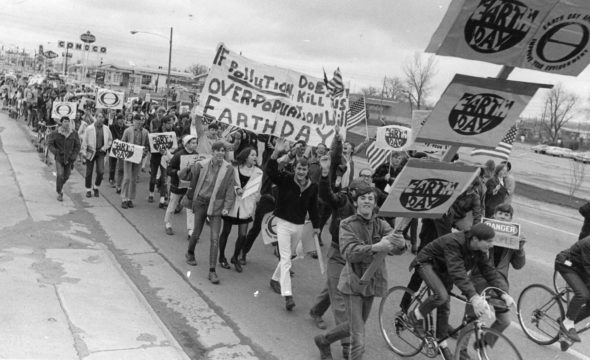Earth Day began in the United States in 1970 as a national day for action on causes affecting the health of the planet – and those who live on it.
The idea for Earth Day came from Gaylord Nelson, a then-U.S. senator from Wisconsin, after witnessing the devastation of an oil spill off the cast of Santa Barbara, California in 1969.
Inspired by the social movements of the 1960s, Nelson and co-founder Dennis Hayes sought to mass mobilize citizens in support of environmental causes without the crippling distraction of political or ideological divide.
The first Earth Day in the United States was held April 22, 1970. The event gathered 20 million Americans from all over the social spectrum–all taking to the streets for the same cause. Events took place in 2,000 colleges and universities, roughly 10,000 primary and secondary schools, and hundreds of communities across the U.S.

U.S. Senator Edmund Muskie, author of the 1970 Clean Air Act, addressing an estimated 40,000-60,000 people for the first Earth Day in Fairmount Park, Philadelphia on April 22, 1970.
In support of the movement, Mayor of New York John Lindsay made Central Park available for Earth Day. The crowd was estimated at more than a million.
Individual environmental groups that had once been isolated in their efforts, suddenly found themselves aligned with thousands of other groups in bringing attention to the cause.
By the end of 1970, the enormous attention Earth Day brought to environmental issues had influenced the creation of the United States Environmental Protection Agency (EPA) and the passage of the Clean Air, Clean Water, and Endangered Species Acts.
In 1990, Earth Day became a global operation, mobilizing over 220 million people in 141 countries. Uniting groups and everyday people, the joined movement helped lead to the 1992 United Nations Earth Summit in Rio de Janeiro. Other international conferences would soon follow where governments and industry joined the science community in search for common solutions to Earth’s challenges.
Today, Earth Day is celebrated by over a billion people worldwide – uniting over 5,000 groups in 192 countries to the common cause.
 CGTN America
CGTN America
 An iconic image captured on the first Earth Day in 1970. (Photo / AP)
An iconic image captured on the first Earth Day in 1970. (Photo / AP)

